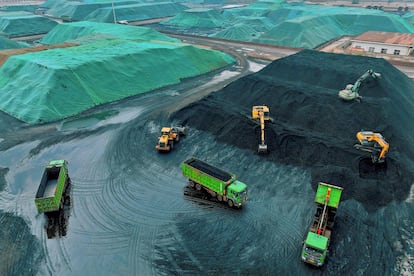Greenhouse gas emissions reach all-time high, placing fossil fuels in the spotlight
The carbon dioxide expelled by the oil, gas, and coal sectors will increase by another 1.1% in 2023


After years in which the focus in climate negotiations was centered mainly on greenhouse gas emissions in general, the debate has clearly shifted at the COP28 summit in Dubai. The main source of these emissions, fossil fuels, is now at the center of discussions. This is partly a consequence of the fact that COP28 is paradoxically being held in a petrostate, but mainly due to the fact that emissions from the oil, gas, and coal sectors continue to increase year-on-year. In addition, the plans of companies and producing countries are pushing humanity towards global warming above the safety levels set by science, while the impacts of the climate crisis are becoming more apparent. A report released Tuesday warns that the carbon dioxide (CO₂) expelled by these sectors will increase by 1.1% in 2023 compared to last year, a new historical record that has put fossil fuels in the spotlight.
The report was prepared by the Global Carbon Project (GCP), comprising a group of dozens of international scientists from more than 90 institutions that has been tracking the evolution of carbon dioxide, the main greenhouse gas, since 2006. During this time, emissions from the fossil fuel sector have grown almost constantly — there have only been two significant drops, during the 2008 financial crisis and the coronavirus pandemic. But with this year’s predicted rise, pre-Covid levels have been exceeded (they are already 1.4% higher than in 2019).
Looking at the data by fuel, coal is number one in terms of total gases expelled. The carbon dioxide generated by this fuel will increase by 1.1% in 2023, according to these experts’ estimates. It is followed by oil, which will expel 1.5% more CO₂ this year than in 2022. Natural gas is third on the list and its emissions will increase by 0.5%. To complete the portrait, we must take the cement sector into account, which will also register an increase of 0.8%.
Many nations are pushing for a clear message from COP28 to eliminate or phase out the use of these fossil fuels. This position, however, is not supported by all the countries present in Dubai, so negotiations will be tough between now and December 12, when the conference is scheduled to close.
Emissions by country
Another way of looking at the evolution of CO₂ emissions is by country. China is by far at the top of this ranking: in 2022 it accounted for 30.7% of the global total, followed by the United States (13.6%), India (7.6%), the European Union (7.4%), Russia (4.4%), and Japan (2.8%).
What happens with this bloc of major emitters sets the global pace of carbon dioxide growth and decline. Analysts at the GCP predict that emissions in the U.S. and EU will fall by 3% and 7.4% respectively this year. However, those of India and China will increase by 8.2% and 4%, respectively. In the rest of the world’s nations, emissions will fall by 0.4%.
Carbon dioxide from land-use changes, mainly linked to deforestation, is expected to fall by about 5.1% from 2022 levels. But this decline is cancelled out by the increase in fossil fuels.
Taking into account the forecasts in the report set for the fossil fuel sector (which will expel 36.8 gigatons of CO₂, the unit used for greenhouse gases, this year) and for those linked to changes in land use (4.1 gigatons), a total of 40.9 gigatons will be expelled in 2023, 0.5% more than in 2022. The good news is that the world is at something close to a plateau where growth in total CO₂ emissions has slowed substantially in the last decade (2013-2022), with an average growth of 0.14% per year, much lower than the 2.1% rate of the previous decade (2003-2012). The bad news is that this is far from sufficient. Emissions must come down drastically and quickly.
Peak emissions
Some studies suggest that greenhouse gas emissions in general have already reached their historical peak in 2023. Pep Canadell, executive director of the Global Carbon Project, acknowledges that the CO₂ expelled by human activities may indeed stop growing this year or in the next two or three. But, he warns, “when we reach the peak, I think we will be there for years, rather than achieving the immediate reduction that is needed. Global decarbonization needs the energy system to change rapidly, which doesn’t seem to be happening sufficiently if fossil fuel emissions continue to grow.”
The current level of emissions over time is “absolutely dangerous and inconsistent with stabilizing the climate at a fixed temperature.” Warming is currently at 1.2ºC (34ºF) above pre-industrial levels. And if emissions are not reduced quickly, we are headed for warming of more than 3ºC, Canadell says. “The increase in global warming can only stop when we have net zero emissions.” But at that point the planet will remain at the temperature it has reached because the gases emitted, when they are expelled into the atmosphere, remain there for decades.
“The impacts of climate change are evident all around us, but the reduction of carbon emissions from fossil fuels is still painfully slow,” says Pierre Friedlingstein, a researcher at the Global Systems Institute at Exeter University and director of the study.
As for the immediate future, Friedlingstein believes that “it now seems inevitable that we will exceed the 1.5ºC target. Leaders going to COP28 will have to agree to rapid cuts in fossil fuel emissions even to keep the 2ºC target alive.” The 2015 Paris Agreement against climate change set the goal that the temperature increase by the end of the century should not exceed 2ºC above pre-industrial levels, and efforts should be made to keep it below 1.5ºC.
The last major review by the Intergovernmental Panel on Climate Change, the group of experts that periodically lays the foundations of scientific knowledge on global warming, considered that the 1.5ºC barrier will be exceeded in a stable manner in the next two decades due to the gases already emitted. The study presented Tuesday points out that with the current level of emissions, there is “a 50% chance that global warming will exceed 1.5ºC degrees consistently in about seven years.”
Carbon sinks and sequestration
Of the total amount of carbon dioxide that human activity releases into the atmosphere, 47% ends up concentrated there for hundreds of years, overheating the planet. The GCP’s analysis estimates that 2023 will end with an atmospheric CO₂ concentration of 419.3 parts per million, which is 51% higher than pre-industrial levels.
The remaining 53% of man-made carbon dioxide is absorbed by vegetation and the ocean in roughly equal parts, which is already causing problems such as increased ocean acidification. As the climate crisis becomes more evident and damaging, more voices are calling for techniques to capture CO₂ from the air. But the report notes that current levels of technology-based carbon dioxide removal (i.e., not including reforestation) amount to approximately 0.01 million tons of CO₂, more than a million times less than current emissions from the fossil fuel sector.
Sign up for our weekly newsletter to get more English-language news coverage from EL PAÍS USA Edition
Tu suscripción se está usando en otro dispositivo
¿Quieres añadir otro usuario a tu suscripción?
Si continúas leyendo en este dispositivo, no se podrá leer en el otro.
FlechaTu suscripción se está usando en otro dispositivo y solo puedes acceder a EL PAÍS desde un dispositivo a la vez.
Si quieres compartir tu cuenta, cambia tu suscripción a la modalidad Premium, así podrás añadir otro usuario. Cada uno accederá con su propia cuenta de email, lo que os permitirá personalizar vuestra experiencia en EL PAÍS.
¿Tienes una suscripción de empresa? Accede aquí para contratar más cuentas.
En el caso de no saber quién está usando tu cuenta, te recomendamos cambiar tu contraseña aquí.
Si decides continuar compartiendo tu cuenta, este mensaje se mostrará en tu dispositivo y en el de la otra persona que está usando tu cuenta de forma indefinida, afectando a tu experiencia de lectura. Puedes consultar aquí los términos y condiciones de la suscripción digital.
More information
Archived In
Últimas noticias
Aquilino Gonell, former Capitol sergeant: ‘If it hadn’t been for the police, the US would be a dictatorship’
A hybrid building: Soccer pitch, housing, and a shopping mall
Europe urges Trump to respect Greenland following annexation threats
Science seeks keys to human longevity in the genetic mixing of Brazilian supercentenarians
Most viewed
- Alain Aspect, Nobel laureate in physics: ‘Einstein was so smart that he would have had to recognize quantum entanglement’
- Mexico’s missing people crisis casts a shadow over World Cup venue
- Why oil has been at the center of Venezuela-US conflicts for decades
- Alvin Hellerstein, a 92-year-old judge appointed by Bill Clinton, to preside over Maduro’s trial in New York
- Cuba confirms death of 32 of its citizens in the US attack against Venezuela










































